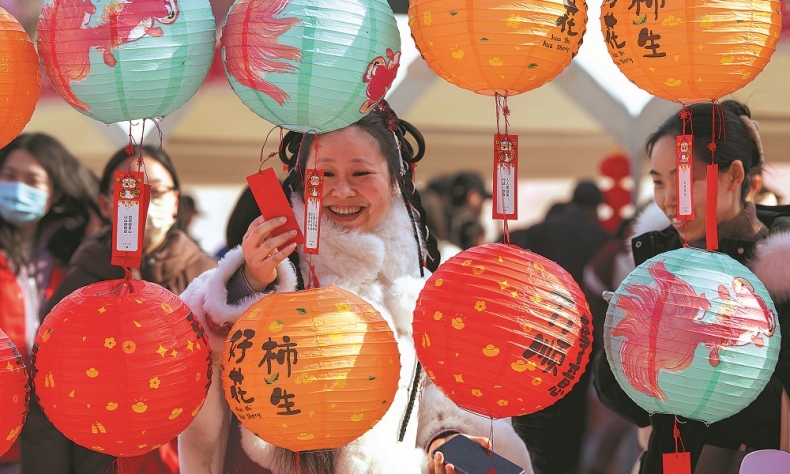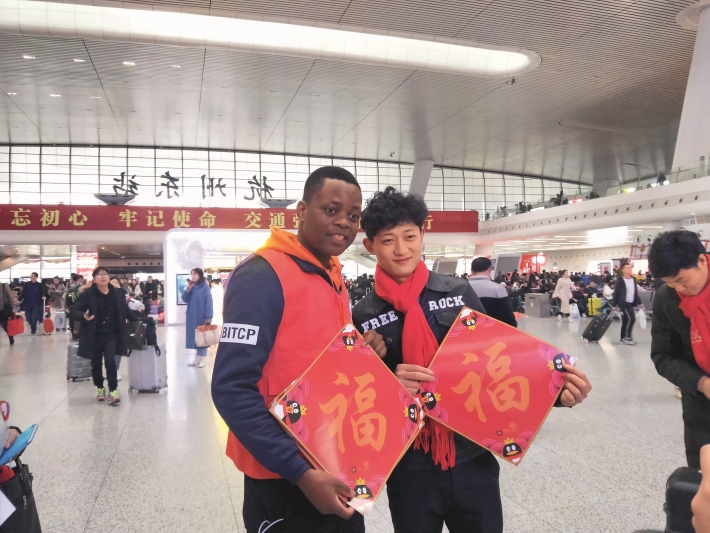Immersing Into a Rich Tradition

Participation in Spring Festival activities gives insights into the richness of Chinese culture.
The Spring Festival is the largest and most important festival in China and among Chinese communities worldwide. Having experienced the festival for six years in China, I have developed a deep appreciation for its cultural, social, and economic significance. This celebration embodies essential themes such as family reunion, wishing for good fortune and well-being, social harmony, and preserving cultural heritage. In recognition of its importance, UNESCO added the Spring Festival to the Representative List of the Intangible Cultural Heritage of Humanity in December 2024.
Mass travel
In 2019, a year after I started my undergraduate studies in Hangzhou, east China’s Zhejiang Province, I worked as a volunteer during chunyun, which refers to the travel rush during the Spring Festival. Working alongside local volunteers at the Hangzhou East Railway Station – one of China’s largest railway hubs covering 340,000 square metres – we provided directions and assistance to travellers during the 40-day chunyun period.
While serving at the station, I witnessed the remarkable scale of the holiday travel, and the figures have been rising since. According to official data released on 6 March 2024, the Hangzhou East Station witnessed over 7 million passenger trips during the 2024 Spring Festival travel rush. This massive movement of people occurs in two distinct peaks: the first surge begins approximately one week before Chinese New Year’s Eve, when most migrant workers and students head home, and the second peak follows the conclusion of the Spring Festival holiday.
Chunyun represents the world’s largest annual human migration, with approximately 9 billion trips made during this period. As these staggering numbers suggest, the Spring Festival holds a special place in the hearts of the Chinese people. The country sees the largest number of activities nationwide and beyond during the festival. Undoubtedly, it is the best time for all Chinese to connect with their families, friends, and ancestors through various means.

Diverse customs
Traditionally, Spring Festival activities begin with the Laba Festival (on the eighth day of the 12th lunar month), which marks the unofficial start of the season, and conclude with the Yuanxiao or Lantern Festival (on the 15th day of the first lunar month), which officially marks the end of the celebrations.
As a volunteer, I had the opportunity to participate in an activity where we prepared Laba porridge, a mixture of various grains and beans symbolising abundance and blessing, to distribute to the elderly in a local community and to travellers at a nearby subway station. This experience provided me with deeper insights into the Laba Festival and its cultural significance. One of the local volunteers there told me that the Laba Festival has its roots in ancient traditions, when it was a time for communities to express gratitude to the gods and ancestors for the year’s harvest, bid farewell to the old year, and welcome the new year together.
Nowadays, red lanterns are easily recognised as one of the symbols of Chinese culture worldwide. While you might see them throughout the year, they are particularly prominent in China during the Yuanxiao Festival, which marks the end of the Spring Festival. During this time, Chinese people gather to eat sweet dumplings made of glutinous rice flour, hang colourful lanterns, play riddle games, enjoy lion dances, and participate in various other folk activities.
Between Laba and Yuanxiao, there are several other important festivals. One is the Little New Year, or xiaonian, also known as the Festival of the Kitchen God, during which Chinese people pray for peace in the coming year and clean their homes, symbolising the end of the old and the beginning of the new year. Another is New Year’s Eve, a time for family dinners and setting off firecrackers. The seven-day Spring Festival public holiday itself features an even wider range of traditional and modern celebrations.
I have spent most of my New Year’s Eves at the homes of my Chinese friends, immersing myself in the festive atmosphere. One standout feature is the Spring Festival couplets and printouts of the Chinese character fu, meaning fortune or blessing, which are pasted on doors. In addition to enjoying the New Year’s Eve dinner, people often stay up late watching the Spring Festival Gala on CCTV and welcoming the new year together.
My Spring Festival experiences in China have profoundly shaped my understanding of the pivotal role traditional festivals play in fostering social cohesion and cultural identity. It’s been a privilege to witness firsthand the joy and anticipation surrounding the festivities: children eagerly donning new clothes, families gathering for joyous reunions, and communities coming together to celebrate. All this underscores the deep-rooted significance of these traditions. The Spring Festival, with its intricate tapestry of folk customs, ancestral reverence, and vibrant celebrations, exemplifies how cultural heritage can enrich lives and strengthen social bonds.
The author is PhD Student in International Affairs and Global Governance, Zhejiang University.
 Facebook
Facebook
 Twitter
Twitter
 Linkedin
Linkedin
 Google +
Google +










